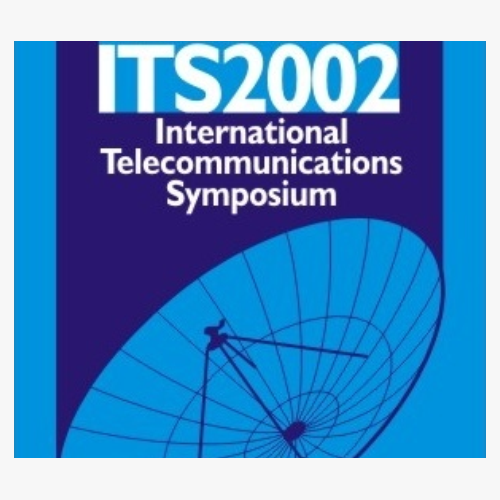
2002 International Telecommunications Symposium

Construction of good space-time trellis codes based on cyclic codes over rings
Raquel Dutra Valença, Reginaldo Palazzo Jr.
DOI: 10.14209/its.2002.215
Keywords:
Abstract
"In this paper, we propose a systematic procedure for constructing good space-time trellis codes derived from cyclic BCH codes over local finite commutative rings. The procedure is based on finding a primitive element in the group of units of the Galois extension ring. For a given design distance, the polynomial generator of a BCH cyclic block code over Q is determined. Such a generator polynomial must contain no binary factor. Hence, the coefficients of the generator polynomial is used as the tap connections for the Q-ary convolutional encoder. Some examples of these codes were tabulated."Download
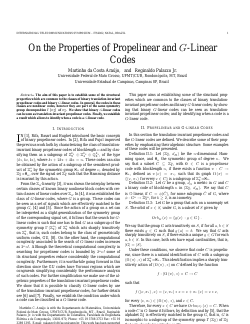
On the properties of Propelinear and G-linear codes
Martinho da Costa Araújo, Reginaldo Palazzo Jr.
DOI: 10.14209/its.2002.220
Keywords:
Abstract
"The aim of this paper is to establish some of the structural properties which are common to the classes of binary translation-invariant propelinear codes and binary G-linear codes. In general, the codes in these classes are nonlinear codes, however they are part of the same symmetry n group decomposition Γ(Z_2^n) of Z_2^2 . We show that binary G-linear codes can be seen as translation-invariant propelinear codes. Finally, we establish a result which allows to identify when a code is a G-linear code."Download

Joint Source/Channel Coding of Multispectral Imagery
Arthur L. A. da Cunha, Weiler A. Finamore, Eduardo A. B. da Silva
DOI: 10.14209/its.2002.223
Keywords:
Abstract
"In this paper we investigate the problem of compressing and reliably transmitting multispectral imagery over binary symmetric channels. A novel source/channel multispectral image coding scheme is proposed. The basic engines of our scheme is a powerful de-correlating transform both in spectral and spatial domains, an optimal bit allocation procedure, block classification and a robust quantizer to cope with the noise introduced by the channel. SNR results show that our coder is very competitive with other approaches when the channel bit error rate is zero, while still attaining robustness to channel errors when the channel is noisy. Furthermore, graceful degradation is also observed as the channel cross increases."Download
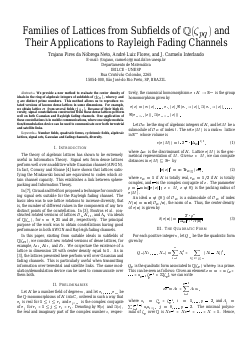
Families of Lattices from Subfields of Q(Cpq) and Their Applications to Rayleigh Fading Channels
Trajano Pires da Nóbrega Neto, André Luiz Flores, J. Carmelo Interlando
DOI: 10.14209/its.2002.228
Keywords: Number fields quadratic forms cyclotomic fields algebraic lattices signal sets Gaussian and fading channels diversity
Abstract
"We provide a new method to evaluate the center density of ideals in the ring of algebraic integers of subfields of Q(Cpq), where p and q are distinct prime numbers. This method allows us to reproduce rotated versions of known dense lattices in some dimensions. For example, we obtain lattice E_8 from several fields Q(Cpq). Because of their high diversity, signal constellations constructed from these dense lattices perform well on both Gaussian and Rayleigh fading channels. One application of these constellations is in mobile communications, where one single modulation/demodulation device can be used to communicate over both terrestrial and satellite links."Download

A New Logic Programmable Audio Switching Matrix
Giuseppe Magdalena Stephan, Fabio da Silva Dutra, Carlos Eduardo F. Savioli, Madjerde Andrade Martins
DOI: 10.14209/its.2002.233
Keywords:
Abstract
"This article describes a logic programmable audio switching matrix developed by this Center to substitute the old mechanical ones in some of the Brazilian Navy ships. With the purpose to switch audio signals only, this new system allows a fast, friendly and easy switching control by an IBM - PC compatible computer and a specific FPGA-based hardware."Download

Methods of Suppression Non-Linearity Products in Terrestrial Digital Video Transmitter
Ivan Milak, Branka Zovko-Cihlar, Borivoj Modlic
DOI: 10.14209/its.2002.239
Keywords:
Abstract
"Intention of the paper is to show in reduced form the methods of suppression non-linearity products in terrestrial digital video transmitter with apply of digital precorrection unit and output filter unit. "Download
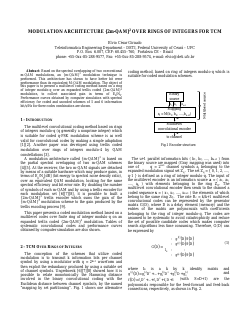
Modulation Architecture {2m-QAM}2 over Rings of Integers for TCM
Elvio César Giraudo
DOI: 10.14209/its.2002.243
Keywords:
Abstract
"Based on the spectral overlapping of two conventional m-QAM modulations, an {m-QAM}^2 modulation technique is performed. This architecture has shown to have better bit error performance than its equivalent M-QAM modulation. The object of this paper is to present a multilevel coding method based on a ring of integer modulo-q over an expanded trellis coded {2m-QAM}^2 modulation, to collect associated gain in terms of Eb/No. Performance curves obtained by computer simulation with spectral efficiency for coded and uncoded schemes of 5 and 6 information bit/s/Hz for three codes combination are shown."Download
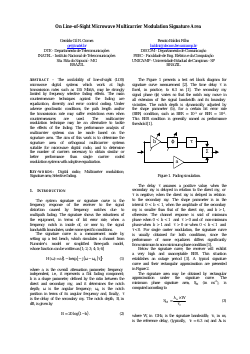
On Line-of-Sight Microwave Multicarrier Modulation Signature Area
Geraldo Gil R. Gomes, Renato Baldini Filho
DOI: 10.14209/its.2002.248
Keywords: Digital radio Multicarrier modulation signature area selective fading
Abstract
"The availability of line-of-sight (LOS) microwave digital systems which work at high transmission rates such as 155 Mbit/s, may be strongly limited by frequency selective fading effects. The main countermeasure techniques against the fading are equalization, diversity and error control coding. Under adverse geoclimatic conditions, the path length and/or the transmission rate may suffer restrictions even when countermeasures are used. The multicarrier modulation technique may be an alternative to tackle the effects of the fading. The performance analysis of multicarrier systems can be made based on the signature area. The aim of this work is to determine the signature area of orthogonal multicarrier systems suitable for microwave digital radio, and to determine the number of carriers necessary to obtain similar or better performance than single carrier coded modulation systems with adaptive equalization. "Download
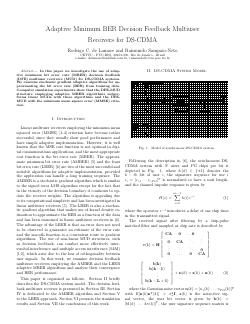
Adaptive Minimum BER Decision Feedback Multiuser Receivers for DS-CDMA
Rodrigo C. de Lamare, Raimundo Sampaio-Neto
DOI: 10.14209/its.2002.254
Keywords:
Abstract
"In this paper we investigate the use of adaptive minimum bit error rate (MBER) decision feedback (DFE) multiuser receivers (MUD) for DS-CDMA systems. We examine stochastic gradient adaptive algorithms for approximating the bit error rate (BER) from training data. Computer simulation experiments show that the DFE-MUD structure employing adaptive MBER algorithms outperforms linear MUDs with these algorithms and the DFEMUD with the minimum mean square error (MMSE) criterion."Download
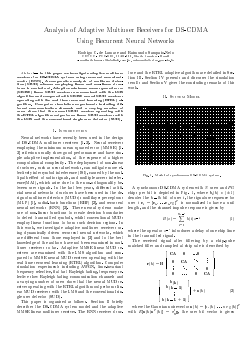
Analysis of Adaptive Multiuser Receivers for DS-CDMA Using Recurrent Neural Networks
Rodrigo C. de Lamare, Raimundo Sampaio-Neto
DOI: 10.14209/its.2002.259
Keywords:
Abstract
"In this paper we investigate adaptive multiuser receivers for DS-CDMA systems using recurrent neural net- works (RNN). A comparative analysis of multiuser detec- tion (MUD) schemes employing linear and non-linear struc- tures is carried out. Adaptive minimum mean squared error (MMSE) linear MUD receivers are examined with the LMS algorithm and compared with MMSE neural MUD receivers operating with the real time recurrent learning (RTRL) al- gorithm. Computer simulation experiments including dif- ferent communication channels and a varying number of users show that the neural MUD receiver operating with the RTRL algorithm outperforms linear MUD receivers with the LMS and the conventional single user detector (SUD)."Download